Ebenthali kupfermark
| Kupfermark | |
|---|---|
| Marco de Cobre (Portuguese) Coppermark (English) | |
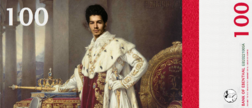 100 kupfermarks note featuring a portrait of King Arthur II. | |
| IMSO 2 | |
| Code | EBM |
| Denominations | |
| Subunit | |
| 1/100 | Pfennig |
| Symbol | 𝒦ℳ |
| Pfennig | ₰ |
| Banknotes | |
| Freq. used | 𝒦ℳ, 5 𝒦ℳ, 10 𝒦ℳ, 20 𝒦ℳ, 50 𝒦ℳ, 100 𝒦ℳ |
| Rarely used | 200 𝒦ℳ |
| Coins | |
| Freq. used | 5 ₰, 10 ₰, 20 ₰, 50 ₰, 1 𝒦ℳ, 2 𝒦ℳ |
| Rarely used | 1 ₰, 2 ₰ |
| Demographics | |
| Date of introduction | 16 January 2022 |
| User(s) | |
| Issuance | |
| Central bank | Bank of Ebenthal |
The Kupfermark (Portuguese: Marco de Cobre, English: Coppermark, symbol: 𝒦ℳ, code: EBM), along with the Conferential Doubloon, is one of the two official currencies of Ebenthal and the country's main domestic currency and legal tender. It is subdivided into 100 pfennigs (abbreviated: ₰). Backed by a copper reserve, the Kupfermark is issued by the Bank of Ebenthal in the form of copper certificates at a fixed exchange rate of 1 to 1 copper milligram. The currency is sometimes referred to as Coppermark in English.
The Kupfermark was introduced at the end of January 2022 as a way to stimulate and restructure Ebenthal's domestic economy, with a currency with real usability (as opposed to a symbolic currency, like most micronational currencies) and a real exchange and trading value.
Etimology
The name Kupfermark is a portmanteau of the German word "Kupfer", meaning copper, to the typically German currency denomination "Mark", meaning "Copper Mark" or "Mark of Copper". It is inspired by the German Empire's Goldmark, whose value was pegged to the gold standard, whereas on the Kupfermark the "gold" is substitute by "kupfer" (copper) because the currency is pegged to a copper standard. The name was created in a joint effort by King Arthur II of Ebenthal along with the Ministry of Commerce Bernardo Barcelos.
History
Background
Following the 8th Conference of Santiago Summit in 1 August 2021 on which Ebenthal participated, it was suggested that the Conferential Doubloon, by then Ebenthal's only official currency, should be substituted by or created as a criptocurrency, and a team was set up, composed of officers from Ebenthal, Eminia and Mauritia, helped by the Grand Republic of Delvera, responsible for studying this possible transition. This is because, it has been argued, that due to the lack of available resources from the member states of the Conference of Santiago to establish a pyrite mineral reserve to back the use, by these micronations, of the CS Doubloon, its factual use by these micronations was unfeasible, being that only Ebenthal has a reserve of [27 kg] of pyrite used to back not only the Doubloon used by Ebenthal, but also by the other States of the Conference, in an economic arrangement that works as a kind of loan with low interest.
Despite the regular operation of the CS Doubloon in Ebenthal and some other micronations, but given the difficulty in universalizing it, the process became exhausting and the national economic prospects became negative.[citation needed] With the election of a new cabinet, Prime Minister Henri Sãens instructed his Minister of Commerce, Mr. Bernardo Barcelos, to join the efforts to reform the Doubloon and/or, alternatively, find a solution to the impending economic crisis. In November 2021, the minister came up with a proposal to create a new intrinsically national currency for domestic use, existing in co-officiality with the CS Doubloon, to which it would be easily convertible, and which would be used for trade between the member states of the Conference of Santiago in a dual currency bond scheme, thus drastically reducing the issuance and circulation of Doubloons and stabilizing not only Ebenthal's economy, but the Doubloon's inflation.
Establishment
As in November 2021 Ebenthal was going through a political crisis, the project to create a new currency was not introduced and Konkrëse until 11 January 2022, when it was taken to the King who, somewhat experienced in micronational finances, took personal responsability for devising an appropriate economic system for the new currency and designing its banknotes and coins, effectively taking the project for himself. In order for Minister Bernardo's plan to stabilize the economy and keep inflation steady works, the new currency should adopt a different monetary system other than the pyrite standard. King Arthur II chose to establish a similar currency system to back the new currency, based on the copper standard, already in use by the Grand Republic of Delvera, whose financial representants he was in contact with, adding that the circulating banknotes would be on form of copper certificates. On 16 January 2022 the Konkrëse voted the adoption of this new currency, whose reasons were presented by the Minister of Commerce and the functioning by the King. The project was approved at the House of Councillors by 11 votes to 3 and at the House of Aristocrats by 7 votes to 6, 1 abstension. Immediatly after, the King decreed the incorporation of 4.1 kg of copper, acquired by himself as a private investor on behalf of the State, into a new branch created in the Ebenthali Royal Treasure.
Current status
Relationship to the Doubloon
Since the adoption of the Kupfermark as the official currency alongside the Conferential Doubloon, the use of the Kupfermark has been encouraged in the domestic market and in commercial relations between the Ebenthali State and foreign investors from internationally recognized nations, due to the real currency exchange rate and value pegged by a copper reserve using the copper standard. In return, the state and government jointly encourage the use of the Conferential Doubloon in intermicronational relations, particularly among the member states of the Conference of Santiago, in order to strengthen ties of union and the establishment of a cohesive micronational market, adopting a dual currency bond.
Relationship to the Vereinsmark
During the Kupfermark creation process, the Ebenthal economic team, responsible for the currency, was in constant contact with the Delvera economic team, from Karnia-Ruthenia, which is developing a currency reform or a new currency for that country, the Vereinsmark. As the development of Kupfermark was inspired by the Curo currency system, currency of the former Grand Republic of Delvera, which was incorporated into Karnia-Ruthenia, the exchange of knowledge brought the idea of creating a fixed exchange rate between Kupfermark and Vereinsmark, which will follow a copper-backed monetary system similar to that of the Ebenthali currency.
The exact model to be followed for the exchange rate will be defined by the finance ministries of Ebenthal and Karnia-Ruthenia once the latter officially adopts the Vereinsmark.
Monetary policy
As the central bank of the Kingdom of Ebenthal which has been delegated authority by the government, the Bank of Ebenthal sets the monetary policy for the Kupfermark by controlling the amount of money in circulation. It has a monopoly on the issuance of banknotes and regulates the amount issued. Unlike banknotes, which are issued by the Bank of Ebenthal itself, all coins are issued under the Bank's command by private mints hired for that purpose.
The monetary system adopted by the Bank of Ebenthal consists of backing the value of currency to the value of the copper decigram. By direct order of the President of the Bank, the Baron of Roches, instructed by the King, the value of backing was stipulated in the decigram, and not in the gram of the metal, as a way of safeguarding private investors who invest in the Ebenthali State, making the currency cheap to maintain, "but not enough to make it commercially unviable or uninteresting". The Ebenthali State acquired 4.1 kg of copper through private investments in the State that are stored in the Bank of Ebenthal.
Exchange rates and value
The Kupfermark makes use of the copper standard, being backed by a reserve of 4,1 kg of copper, at the fixed exchange rate of 1 Kupfermark to 0.001 copper gram (1 milligram). Conversion to other currencies is done through the value of the amount of copper referring to the amount to be exchanged in Kupfermarks The currency is convertible to any currency, but the exchange commonly takes place between the value of copper (accordingly to what it is owed in Kupfermark) and the Brazilian Real, but also the US Dollar and the Euro.
Conversion diagram: 1 Kupfermark = 0.001 copper gram = the value of a gram of copper in the currency to be exchanged.
Updated rates
As of 2022 a kilogram of copper costs 54.3 BRL, 9.75 USD, 7.20 GBP or 8.57 EUR.
- 1 Kupfermark = 0.001g = 0,00005 BRL
- 2 Kupfermarks = 0.002g = 0,0001 BRL
- 5 Kupfermarks = 0.005g = 0,0003 BRL
- 10 Kupfermarks = 0.01g = 0,0005 BRL
- 20 Kupfermarks = 0.02g = 0,001 BRL
- 50 Kupfermarks = 0.05g = 0,003 BRL
- 100 Kupfermarks = 0.1g = 0,005 BRL
- 200 Kupfermarks = 0.2g = 0,01 BRL
- 500 Kupfermarks = 0.5g = 0,03 BRL
- 1000 Kupfermarks = 1.0g = 0,05 BRL
Banknotes
First series
The first series of Kupfermark banknotes were officially launched on 3 February 2022. The banknotes were designed by King Arthur II and approved by parliament in session on the 30th of January. The images used in the banknote design represent Ebenthal in many ways; its culture, its geography, its history, its wealth. The back of the notes has been standardized by determination of the General Manager of the Royal Treasury, sanctioned by the President of the Bank of Ebenthal. This series have been discontinued in 1 October 2022.
| Banknotes: First Series (30 January - 1 October 2022) | ||||||||||||||||||||||||||||||||||||||||||||||||||||||||||||||||||||||||||||||||||||
|---|---|---|---|---|---|---|---|---|---|---|---|---|---|---|---|---|---|---|---|---|---|---|---|---|---|---|---|---|---|---|---|---|---|---|---|---|---|---|---|---|---|---|---|---|---|---|---|---|---|---|---|---|---|---|---|---|---|---|---|---|---|---|---|---|---|---|---|---|---|---|---|---|---|---|---|---|---|---|---|---|---|---|---|---|
| ||||||||||||||||||||||||||||||||||||||||||||||||||||||||||||||||||||||||||||||||||||
Second series
The second series of Kupfermark banknotes were officially released on 1 October 2022. The banknotes were designed by King Arthur II and approved by parliament in session on the same day. The observe presents a portrait of King Arthur II, and the reverse a painting depicting Saint James, patron saint of Ebenthal and whose cross is Ebenthal's supreme symbol.
| Image | Value | Dimensions (millimetres) |
Main Colour | Design | |||
|---|---|---|---|---|---|---|---|
| Obverse | Reverse | Obverse | Reverse | ||||

|

|
𝒦ℳ 5 | 136.8 x 64.9 | Flame | "King Arthur II Self-Portrait" (2022) by Arthur van der Bruyn | "Saint James the Greater" (1638) by Guido Reni | |

|

|
𝒦ℳ 10 | 136.8 x 64.9 | Violet | "King Arthur II Self-Portrait" (2022) by Arthur van der Bruyn | "Saint James the Greater" (1638) by Guido Reni | |

|

|
𝒦ℳ 20 | 136.8 x 64.9 | Dark spring green | "King Arthur II Self-Portrait" (2022) by Arthur van der Bruyn | "Saint James the Greater" (1638) by Guido Reni | |

|

|
𝒦ℳ 50 | 136.8 x 64.9 | Astronaut | "King Arthur II Self-Portrait" (2022) by Arthur van der Bruyn | "Saint James the Greater" (1638) by Guido Reni | |

|

|
𝒦ℳ 100 | 136.8 x 64.9 | Carmine | "King Arthur II Self-Portrait" (2022) by Arthur van der Bruyn | "Saint James the Greater" (1638) by Guido Reni | |

|

|
𝒦ℳ 200 | 136.8 x 64.9 | Amber | "King Arthur II Self-Portrait" (2022) by Arthur van der Bruyn | "Saint James the Greater" (1638) by Guido Reni | |
Special series
Coins
First series
The first series of Kupfermark coins were officially launched on 27 June 2022. The coins were designed by King Arthur II and enforced through Royal Decree. The coins follow a pattern and feature Ebenthal's small arms on their face, along with the coin's name and value, coinage date and the inscription "Kupfermark centime" next to the Pfennig symbol.
| Value | Image (2022–present) |
Main colour |
Secondary colour |
Diameter (mm) |
Thickness (mm) |
Mass (g) |
Composition | Edge | ||
|---|---|---|---|---|---|---|---|---|---|---|
| 1₰ | 
|
Bronze | None | 16.25 | 1.67 | 2.3 | Copper-covered steel | Smooth | ||
| 2₰ | 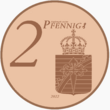
|
18.75 | 1.67 | 3.06 | Smooth with a groove | |||||
| 5₰ | 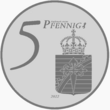
|
Silver | 21.25 | 1.67 | 3.92 | Smooth | ||||
| 10₰ | 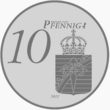
|
19.75 | 1.93 | 4.1 | Nordic gold | Shaped edge with fine scallops | ||||
| 20₰ | 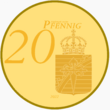
|
Gold | 22.25 | 2.14 | 5.74 | Plain with seven indents | ||||
| 50₰ | 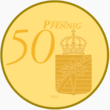
|
24.25 | 2.38 | 7.8 | Shaped edge with fine scallops | |||||
| 𝒦ℳ 1 | 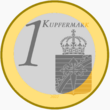
|
Silver | Gold | 23.25 | 2.33 | 7.5 | Outer part: nickel brass Inner part: Layers of copper-nickel, nickel, copper-nickel |
Interrupted milled | ||
| 𝒦ℳ 2 | 
|
Gold | Silver | 25.75 | 2.2 | 8.5 | Outer part: copper-nickel Inner part: Layers of nickel brass, nickel, nickel brass. |
Edge lettering, fine milled | ||

















